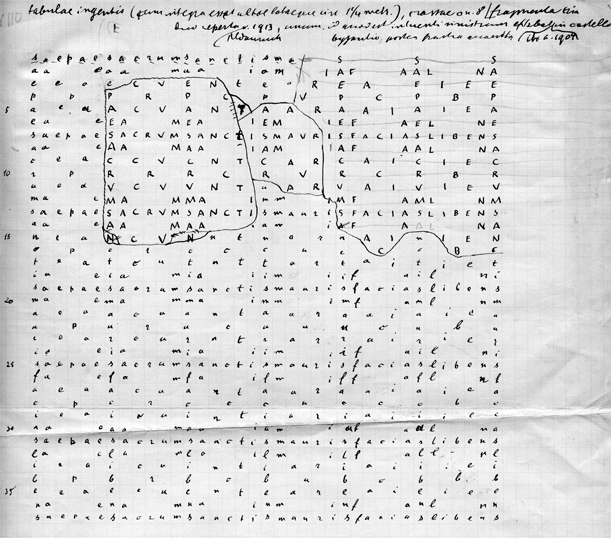Roman North Africa, especially the provinces of Mauretania Caesariensis and Numidia, i.e. the territory of today’s Algeria, is particularly blessed with Latin inscriptions that are written in verses.
A surprisingly artistic grid inscription has only recently been recognized as such a verse inscription. It is to be regretted that apart from the epigraphic records of some leading scholars of the 19th century, the original has not survived. Nor do I know of any photo of this extraordinary inscription, so that we have to be content with the drawing by Hermann Dessau, the famous Berlin epigrapher, whose notes on Roman inscriptions are still preserved in the archives of the ‘Corpus Inscriptionum Latinarum’ in Berlin.
In Madauros, the African city that became famous for Apuleius, the writer of the ‘Golden Ass’, the French scholar Stéphane Gsell luckily had reported the fragments of an enormous square plaque, the original full measurements of which must have been around 1.30m by 1.30m. «Notre table, probablement placée sur le forum de Madauros, était un avertissement donné aux dévots sous une forme ingenieuse».
The inscription was adressed to the worshippers of the African deities, the dii Mauri. But how was this ‘avertissement’, this admonition designed? In a really sophisticated and elaborate way:
SAEPAE SACRVM SANCTIS MAVRIS FACIAS LIBENS
This phrase is repeated in horizontal, vertical and diagonal script on a chess-board-like grid which originally made up 36 squares (each with sides of 3.5 cm). Gsell first considered this a tabula lusoria, but later corrected this view in his edition, in which he raised the point that the many small squares were scarcely suitable for a game. He rightly restored the whole piece on the basis of the likelihood that the first and last horizontal lines will have repeated the entire phrase: «il est probable que la 1ère ligne horizontale (comme la dernière) repétait toute la formule». And this is how Dessau reconstructed the inscription in his drawing. The grid itself was thus composed of 1,369 (= 37 by 37) small squares, each of which held one letter:

But neither Gsell nor Dessau could provide an adequate explanation of this inscription, its unusual spelling or its composition. I see it as a magic square of letters, which presents a sophisticated play on the number six: the six words Saepae sacrum sanctis Mauris facias libens appear written variously in horizontal, vertical and diagonal script. Three of these words begin with S, three end with this letter. These words, in turn, each contain six letters: sacrum, Mauris, facias, libensand also saepae. Only the form sanctis, with seven letters, does not conform to this pattern, as it not only begins with S, but also ends with a seventh letter, S – intentionally. For, to present six times six interlinked squares, not six but seven horizontal and vertical lines are required to form the sides of the squares. Therefore, the acrostic formula on, for example, the left-hand-side requires not 36 but 37 letters to provide the same reading on the lowest, horizontal line of letters.
Further – something which has not been noticed either – the phrase presented in these variations forms an iambic senarius – i.e. a play on the number six in poetic form, too. Thus the spelling saepae reflects not only a wish for a word with six letters, but also an attempt to insist on a longum in the second syllable of the first iambus by spelling saepeas saepae:
Saepáe sacrúm sanctís Maurís faciás libéns.
“Sacrifice frequently and gladly to the Moorish Gods”.
To sum this up: in six times six squares, an iambic senarius is repeated vertically, horizontally and diagonally, the senarius made up of six feet and six words each with six letters (all except sanctis).
For further reading see: M G. Schmidt, Inscriptions from Madauros (CIL VIII 28086-28150), in: A. Mastino al. (ed.), L’Africa Romana XVII: Le ricchezze dell’Africa. Risorse, produzioni, scambi (Sevilla 14-17 dicembre 2006), Roma 2008, esp. 1916–1919.